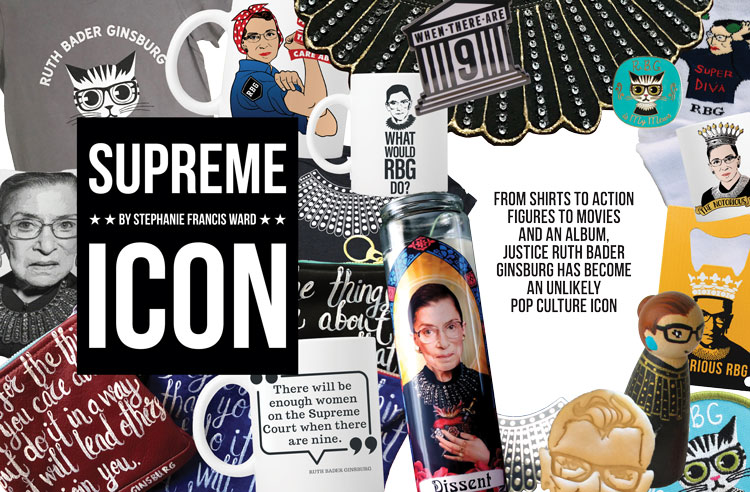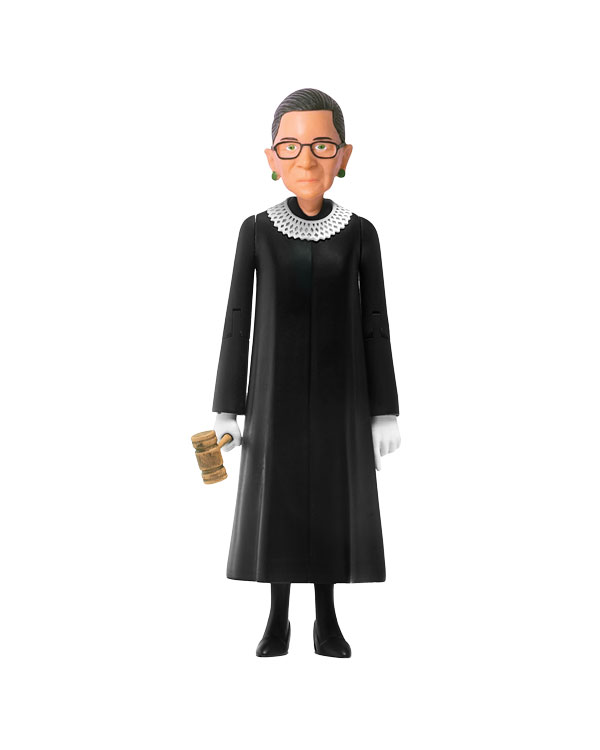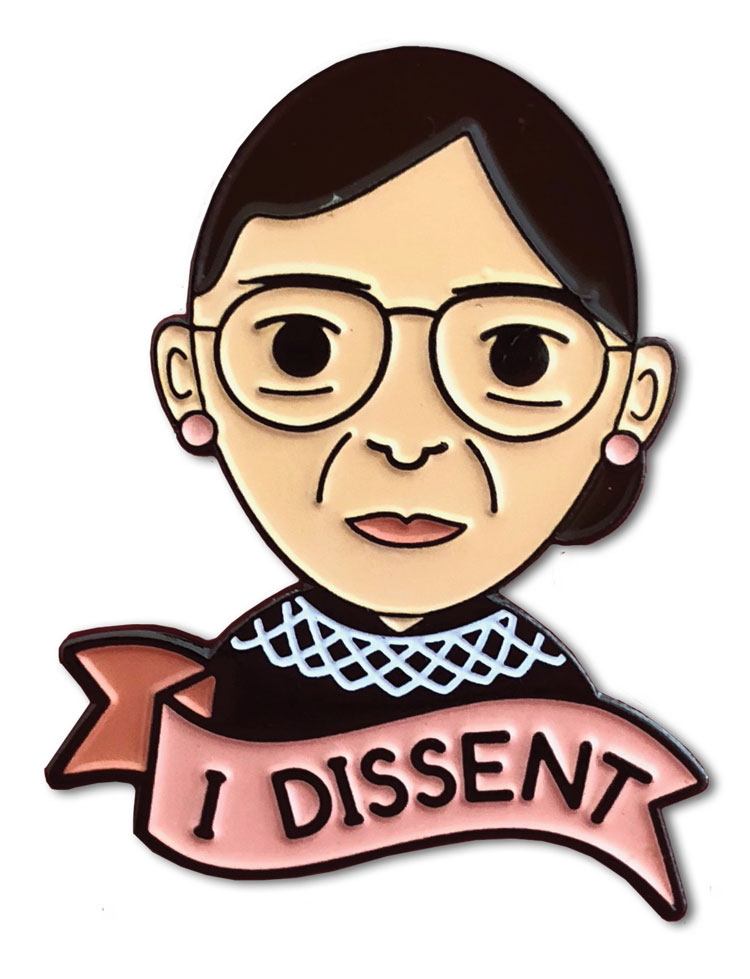Justice Ruth Bader Ginsburg has become an unlikely pop culture icon

Photos by Monique Karlov, Foxy Mug, Squirrel Den Studio, Brittney Boe, Dissentpins.com, Sudie’s Corner, Jittermug, Kateen Thiry, Starkleshop, Abbie Briggs, Turnerandpoochco.etsy.com, Maggie Stern, The Eternal Flame.
On the website Etsy, which sells crafts and vintage items, typing “Ruth Bader Ginsburg” into the search bar yields more than 1,000 results.
You can buy a birthday card with the associate justice’s image and the phrase “small and mighty” written in pink. There’s also a tank top bearing her stern visage and “I dissent” written underneath. There are posters of her as Rosie the Riveter, peg dolls of her in full judicial regalia and even prayer candles portraying her as “the Patron Saint of the Supreme Court.”
See our gallery: RBG Supreme: The Merchandising of Justice Ruth Bader Ginsburg
If Etsy isn’t your thing, you can find a Ginsburg action figure on Kickstarter, complete with gavel, pointing finger and her “iconic jabot,” a frilly, fancy-looking collar perfect for making “fashion and judicial statements.” The initial funding goal was $15,000. As of September, it had raised well over $600,000. “She is a rock star. She is an inspiration. She is constantly fighting. She is brilliant and fearless,” the introductory video to the Kickstarter page states. “She is an icon.”

Photo of Ruth Bader Ginsburg action figure courtesy of FCTRY
The items aren’t all kitschy. There are plenty of posters, coffee mugs and shirts featuring inspirational and even strident quotes from her speeches and opinions. One oft-used line came from an interview she gave shortly after Sonia Sotomayor was nominated to the Supreme Court in 2009: “Women belong in all places where decisions are being made.” Another popular one for product designers is: “Fight for the things you care about.”
That latter quote was from a 2015 luncheon at the Radcliffe Institute for Advanced Study at Harvard University in Justice Ginsburg’s honor. Oftentimes, these products will leave off the last part of Ginsburg’s sentence, which was “but do it in a way that will lead others to join you.” That outlook may explain why Ginsburg has become a cottage industry, generating countless products—none of which she has likely endorsed but has often been a good sport about.
And that’s just the tip of the iceberg. There is a music album inspired by her life story. There are websites and memes that celebrate her jurisprudence, her fiery dissents and her dedication to civil rights, gender equality and social justice. There’s even a recent documentary and an upcoming Hollywood film chronicling her long and storied career as a litigator fighting on behalf of gender equality.
That tireless devotion to doing what she believes is right is one reason why Ginsburg has emerged as an unlikely pop culture icon. Ginsburg, who became only the second woman to serve on the U.S. Supreme Court when she was appointed by President Bill Clinton in 1993, has built a career overcoming the odds. Prior to becoming a federal judge, she argued six gender discrimination cases before the high court, winning five. Much like her celebrated predecessor on the Supreme Court, Justice Thurgood Marshall, Ginsburg’s litigation success and subsequent judicial career has led to her being perceived as a civil rights icon. That she has crossed over into the mainstream says a lot about where this country is today, as well as what kind of heroes people are looking for.
Indeed, you can be an upper middle-class, a suburban stay-at-home mom, an urban graduate student who identifies as genderqueer/nonbinary or a rural America retiree who voted for Donald Trump and still admire Ginsburg, according to marketing experts, who say that her appeal with various groups is unique. And the attention the Me Too movement has brought to sexual harassment and rape has made many more people interested in speaking about gender discrimination publicly—issues Ginsburg has been addressing and fighting for decades.
“She’s our Venn diagram of feminism. She’s relatable because she’s fighting for what she cares about, but she’s not doing it in a way that’s off-putting, and anyone can relate to it,” says Courtney Vickery, an Etsy retailer based in San Francisco whose wares include enamel push-back pins, with a line drawing she made of Ginsburg’s face and the words “I dissent.”

Photo of Justice Ginsburg attending confirmation hearings in 1993 by Rob Crandall/Shutterstock.com
Holding Out for a Hero
Ginsburg’s transition to pop culture figure began before Trump took office.
In 2013, a Tumblr meme of Ginsburg wearing a skewed crown and one of her trademark jabots while bearing the moniker of “the Notorious R.B.G.” went viral. The image was inspired by a photo of the late rapper Christopher Wallace, also known as “the Notorious B.I.G.” Shana Knizhnik, a former New York University law student, created the meme in response to the Supreme Court’s decision in Shelby County v. Holder, striking down a portion of the Voting Rights Act of 1965 that required certain jurisdictions to get preclearance from the U.S. Department of Justice before being allowed to change their voting laws. Feeling outraged, Knizhnik was inspired by a pithy line in Ginsburg’s dissent: “Throwing out preclearance when it has worked and is continuing to work to stop discriminatory changes is like throwing away your umbrella in a rainstorm because you are not getting wet.”
Sales for items featuring Ginsburg have picked up since Trump took office, say Vickery and other online sellers. And marketing experts say that the January 2017 Women’s March on Washington also played a role in the growing popularity of Ginsburg merchandise. A worldwide event that attracted at least 3.2 million people in the United States, many participants wore clothing and accessories expressing their anger about Trump, who had been captured on video talking about grabbing women by their genitals, which he later described as “locker-room talk.” Additionally, participants cited specific complaints about the Trump administration including exceptions put in the Affordable Care Act to cut no-cost contraceptive coverage, freezing an Obama administration equal pay initiative and ending asylum protections for immigrants who experienced domestic violence in their countries.
Ginsburg, with her small, frail-looking stature and genteel demeanor, presents an ideal role model for people who want to express their disagreement with the current administration without appearing completely disagreeable. The justice rarely, if ever, appears angry or flustered, even when she’s reading one of her infamous dissents from the bench while wearing her dissent jabot, a black velvet variation with jeweled studs that she wears whenever she disagrees with the majority.

Photo courtesy of Courtney Vickery
Vickery, a commercial illustrator who has designed for the retail chains Hot Topic, Urban Outfitters and Claire’s Accessories, says she designed the “I Dissent” Ginsburg pin the night before the 2017 presidential inauguration as a way to deal with concern about Trump becoming the country’s president.
After all, it was an issue that Ginsburg herself seemed concerned about. During a 2016 CNN interview, she described then-presidential candidate Trump as “a faker,” who “really has an ego.” Trump complained through a series of tweets, and the justice issued an apology statement the next day.
Monique Karlov, a Washington state Etsy retailer, sells jabots inspired by the one Ginsburg puts on for her dissents. A former pharmacy researcher, Karlov wore one of her jabot pieces to the Seattle women’s march.
“I think people are so frustrated with the current administration and everything that is going on. To have something you can wear that’s bold and attractive, I think that’s a way of making a statement without actually having to say anything, or possibly engage without having an argument,” says Karlov, who estimates that she’s sold more than 300 jabots since 2017.
This article was published in the October 2018 ABA Journal magazine with the title "Supreme Icon."




